Comprehensive Accounting and Financial Analysis Assignment - Finance
VerifiedAdded on 2023/04/19
|15
|2563
|97
Homework Assignment
AI Summary
This finance assignment delves into various aspects of accounting and financial analysis. It begins with calculations related to loan payments, comparing weekly and fortnightly payment schedules, and analyzing investment returns for different scenarios. The assignment then explores dividend policies, comparing classical and imputation taxation systems and their impact on investors. It analyzes the differences in tax methods, reduction in double taxation, and the impact on investor's investments. The assignment also includes detailed calculations of returns, standard deviations, and portfolio analysis, utilizing the Capital Asset Pricing Model (CAPM) to evaluate expected returns and risks for different assets. The analysis covers both individual asset performance and portfolio optimization, providing a comprehensive overview of financial concepts.
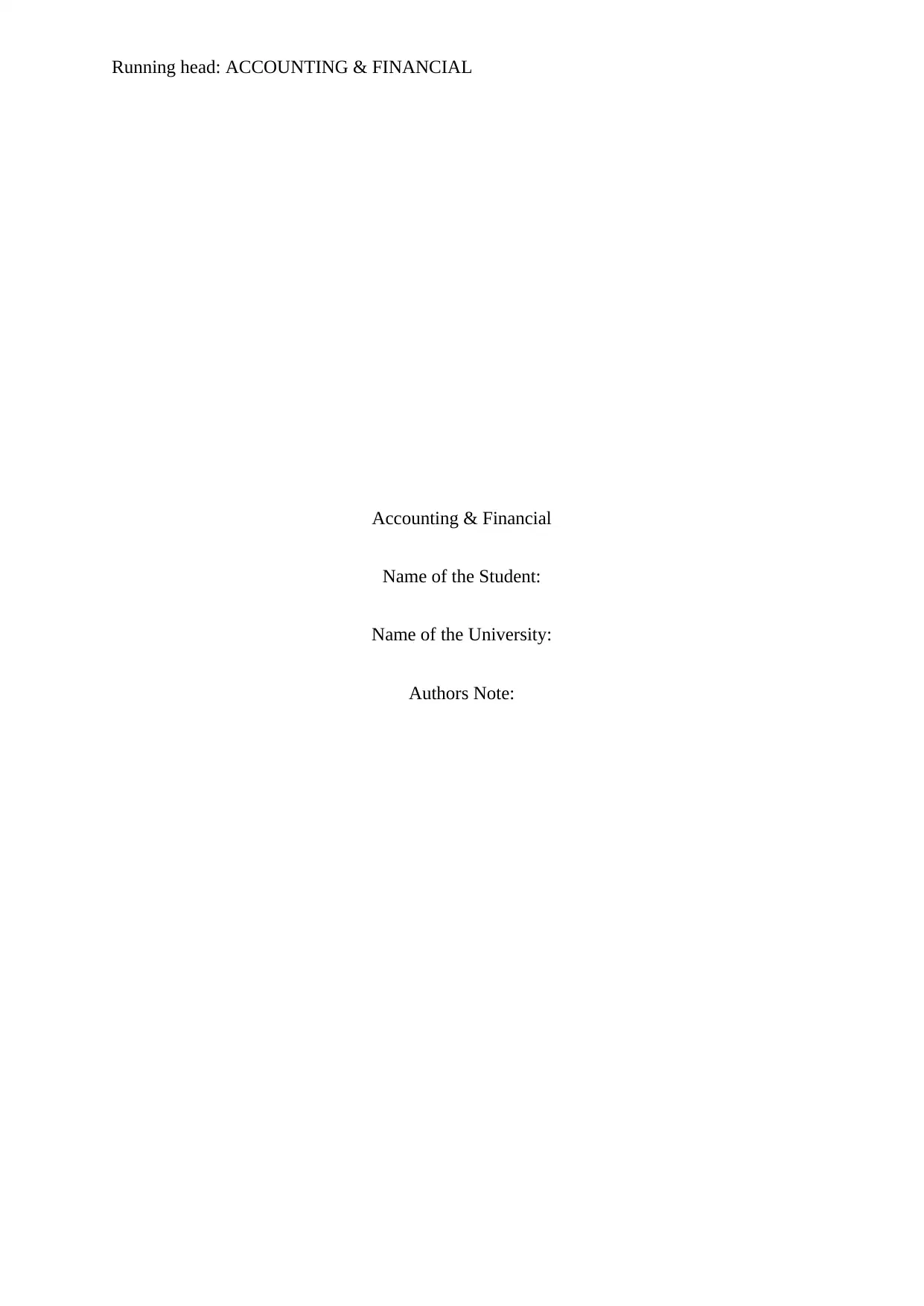
Running head: ACCOUNTING & FINANCIAL
Accounting & Financial
Name of the Student:
Name of the University:
Authors Note:
Accounting & Financial
Name of the Student:
Name of the University:
Authors Note:
Paraphrase This Document
Need a fresh take? Get an instant paraphrase of this document with our AI Paraphraser

ACCOUNTING & FINANCIAL 2
Table of Contents
Question 1:.................................................................................................................................3
Answer to a.i):............................................................................................................................3
Answer to a.ii):...........................................................................................................................3
Answer to b.i):............................................................................................................................4
Answer to b.ii):...........................................................................................................................4
Answer to b.iii):.........................................................................................................................4
Question 2:.................................................................................................................................5
Answer to i):...............................................................................................................................5
Answer to ii):..............................................................................................................................5
Question 3:.................................................................................................................................6
Answer to i):...............................................................................................................................6
Answer to ii):..............................................................................................................................7
Answer to iii):............................................................................................................................9
Question 4:...............................................................................................................................10
Answer to 1):............................................................................................................................10
Answer to 2):............................................................................................................................11
Answer to 3):............................................................................................................................11
Answer to 4):............................................................................................................................12
Answer to 5):............................................................................................................................12
Answer to 6):............................................................................................................................12
Answer to 7):............................................................................................................................13
Answer to 8):............................................................................................................................13
Answer to 9):............................................................................................................................13
Reference and Bibliography:....................................................................................................14
Table of Contents
Question 1:.................................................................................................................................3
Answer to a.i):............................................................................................................................3
Answer to a.ii):...........................................................................................................................3
Answer to b.i):............................................................................................................................4
Answer to b.ii):...........................................................................................................................4
Answer to b.iii):.........................................................................................................................4
Question 2:.................................................................................................................................5
Answer to i):...............................................................................................................................5
Answer to ii):..............................................................................................................................5
Question 3:.................................................................................................................................6
Answer to i):...............................................................................................................................6
Answer to ii):..............................................................................................................................7
Answer to iii):............................................................................................................................9
Question 4:...............................................................................................................................10
Answer to 1):............................................................................................................................10
Answer to 2):............................................................................................................................11
Answer to 3):............................................................................................................................11
Answer to 4):............................................................................................................................12
Answer to 5):............................................................................................................................12
Answer to 6):............................................................................................................................12
Answer to 7):............................................................................................................................13
Answer to 8):............................................................................................................................13
Answer to 9):............................................................................................................................13
Reference and Bibliography:....................................................................................................14
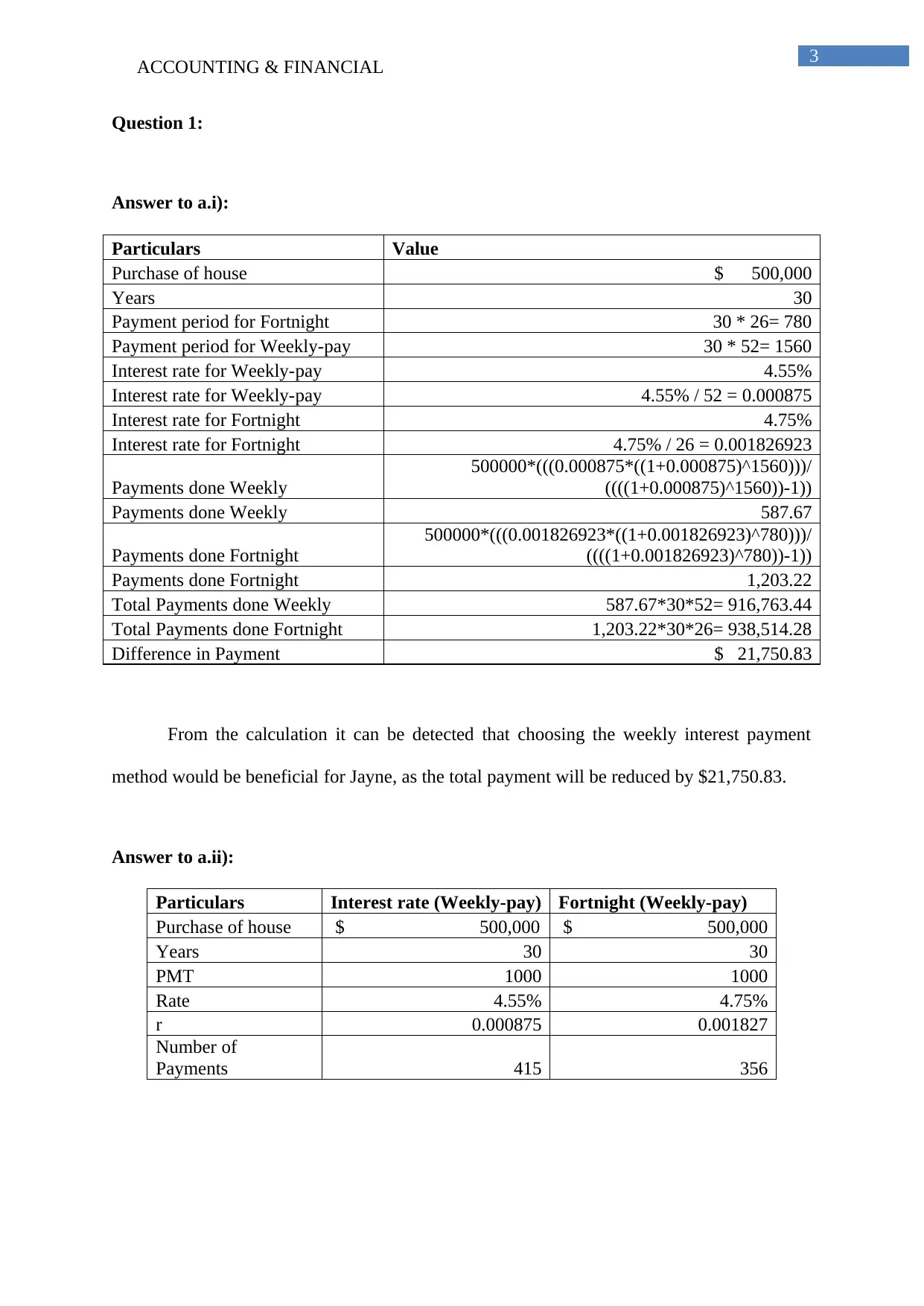
ACCOUNTING & FINANCIAL 3
Question 1:
Answer to a.i):
Particulars Value
Purchase of house $ 500,000
Years 30
Payment period for Fortnight 30 * 26= 780
Payment period for Weekly-pay 30 * 52= 1560
Interest rate for Weekly-pay 4.55%
Interest rate for Weekly-pay 4.55% / 52 = 0.000875
Interest rate for Fortnight 4.75%
Interest rate for Fortnight 4.75% / 26 = 0.001826923
Payments done Weekly
500000*(((0.000875*((1+0.000875)^1560)))/
((((1+0.000875)^1560))-1))
Payments done Weekly 587.67
Payments done Fortnight
500000*(((0.001826923*((1+0.001826923)^780)))/
((((1+0.001826923)^780))-1))
Payments done Fortnight 1,203.22
Total Payments done Weekly 587.67*30*52= 916,763.44
Total Payments done Fortnight 1,203.22*30*26= 938,514.28
Difference in Payment $ 21,750.83
From the calculation it can be detected that choosing the weekly interest payment
method would be beneficial for Jayne, as the total payment will be reduced by $21,750.83.
Answer to a.ii):
Particulars Interest rate (Weekly-pay) Fortnight (Weekly-pay)
Purchase of house $ 500,000 $ 500,000
Years 30 30
PMT 1000 1000
Rate 4.55% 4.75%
r 0.000875 0.001827
Number of
Payments 415 356
Question 1:
Answer to a.i):
Particulars Value
Purchase of house $ 500,000
Years 30
Payment period for Fortnight 30 * 26= 780
Payment period for Weekly-pay 30 * 52= 1560
Interest rate for Weekly-pay 4.55%
Interest rate for Weekly-pay 4.55% / 52 = 0.000875
Interest rate for Fortnight 4.75%
Interest rate for Fortnight 4.75% / 26 = 0.001826923
Payments done Weekly
500000*(((0.000875*((1+0.000875)^1560)))/
((((1+0.000875)^1560))-1))
Payments done Weekly 587.67
Payments done Fortnight
500000*(((0.001826923*((1+0.001826923)^780)))/
((((1+0.001826923)^780))-1))
Payments done Fortnight 1,203.22
Total Payments done Weekly 587.67*30*52= 916,763.44
Total Payments done Fortnight 1,203.22*30*26= 938,514.28
Difference in Payment $ 21,750.83
From the calculation it can be detected that choosing the weekly interest payment
method would be beneficial for Jayne, as the total payment will be reduced by $21,750.83.
Answer to a.ii):
Particulars Interest rate (Weekly-pay) Fortnight (Weekly-pay)
Purchase of house $ 500,000 $ 500,000
Years 30 30
PMT 1000 1000
Rate 4.55% 4.75%
r 0.000875 0.001827
Number of
Payments 415 356
⊘ This is a preview!⊘
Do you want full access?
Subscribe today to unlock all pages.

Trusted by 1+ million students worldwide
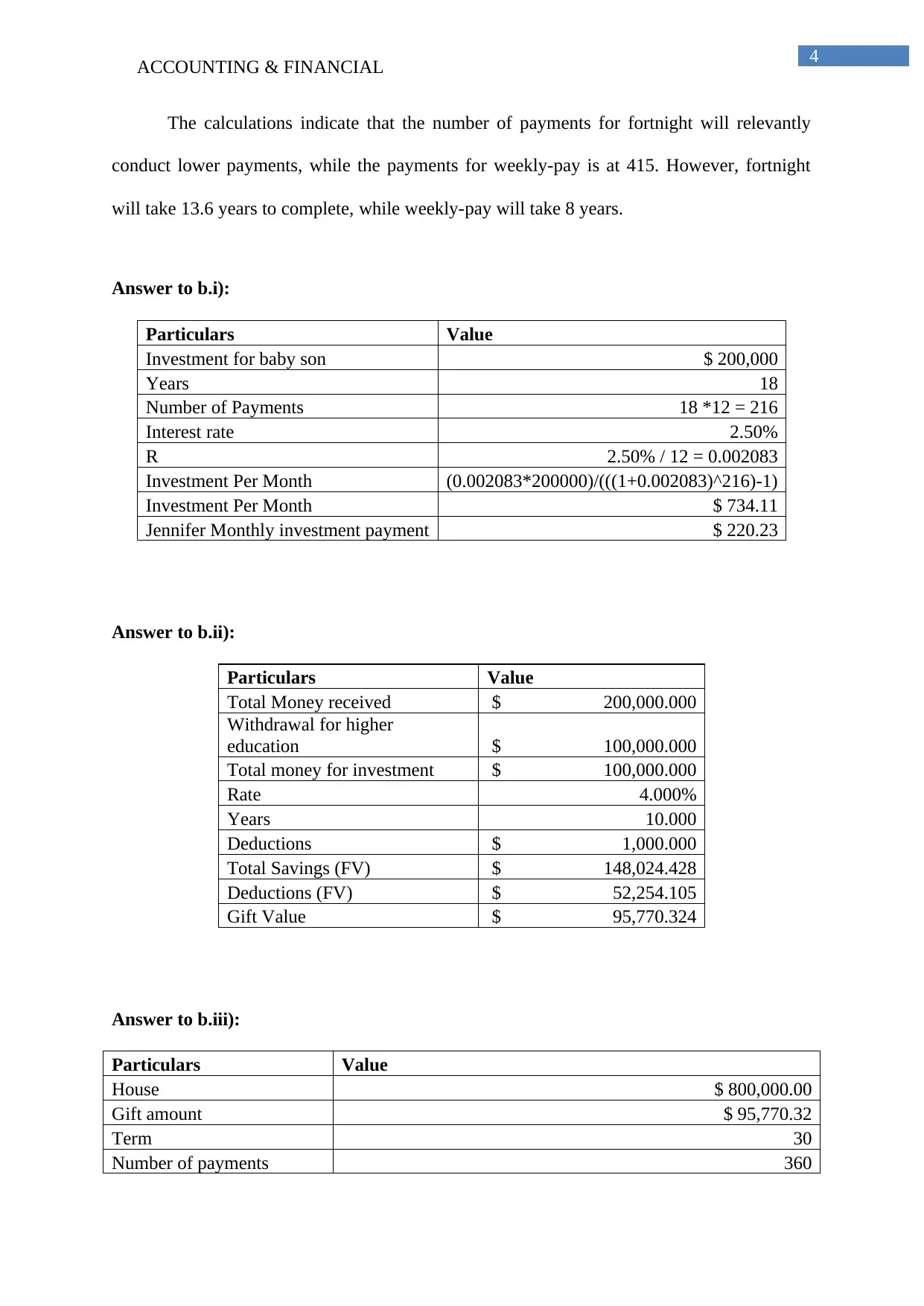
ACCOUNTING & FINANCIAL 4
The calculations indicate that the number of payments for fortnight will relevantly
conduct lower payments, while the payments for weekly-pay is at 415. However, fortnight
will take 13.6 years to complete, while weekly-pay will take 8 years.
Answer to b.i):
Particulars Value
Investment for baby son $ 200,000
Years 18
Number of Payments 18 *12 = 216
Interest rate 2.50%
R 2.50% / 12 = 0.002083
Investment Per Month (0.002083*200000)/(((1+0.002083)^216)-1)
Investment Per Month $ 734.11
Jennifer Monthly investment payment $ 220.23
Answer to b.ii):
Particulars Value
Total Money received $ 200,000.000
Withdrawal for higher
education $ 100,000.000
Total money for investment $ 100,000.000
Rate 4.000%
Years 10.000
Deductions $ 1,000.000
Total Savings (FV) $ 148,024.428
Deductions (FV) $ 52,254.105
Gift Value $ 95,770.324
Answer to b.iii):
Particulars Value
House $ 800,000.00
Gift amount $ 95,770.32
Term 30
Number of payments 360
The calculations indicate that the number of payments for fortnight will relevantly
conduct lower payments, while the payments for weekly-pay is at 415. However, fortnight
will take 13.6 years to complete, while weekly-pay will take 8 years.
Answer to b.i):
Particulars Value
Investment for baby son $ 200,000
Years 18
Number of Payments 18 *12 = 216
Interest rate 2.50%
R 2.50% / 12 = 0.002083
Investment Per Month (0.002083*200000)/(((1+0.002083)^216)-1)
Investment Per Month $ 734.11
Jennifer Monthly investment payment $ 220.23
Answer to b.ii):
Particulars Value
Total Money received $ 200,000.000
Withdrawal for higher
education $ 100,000.000
Total money for investment $ 100,000.000
Rate 4.000%
Years 10.000
Deductions $ 1,000.000
Total Savings (FV) $ 148,024.428
Deductions (FV) $ 52,254.105
Gift Value $ 95,770.324
Answer to b.iii):
Particulars Value
House $ 800,000.00
Gift amount $ 95,770.32
Term 30
Number of payments 360
Paraphrase This Document
Need a fresh take? Get an instant paraphrase of this document with our AI Paraphraser
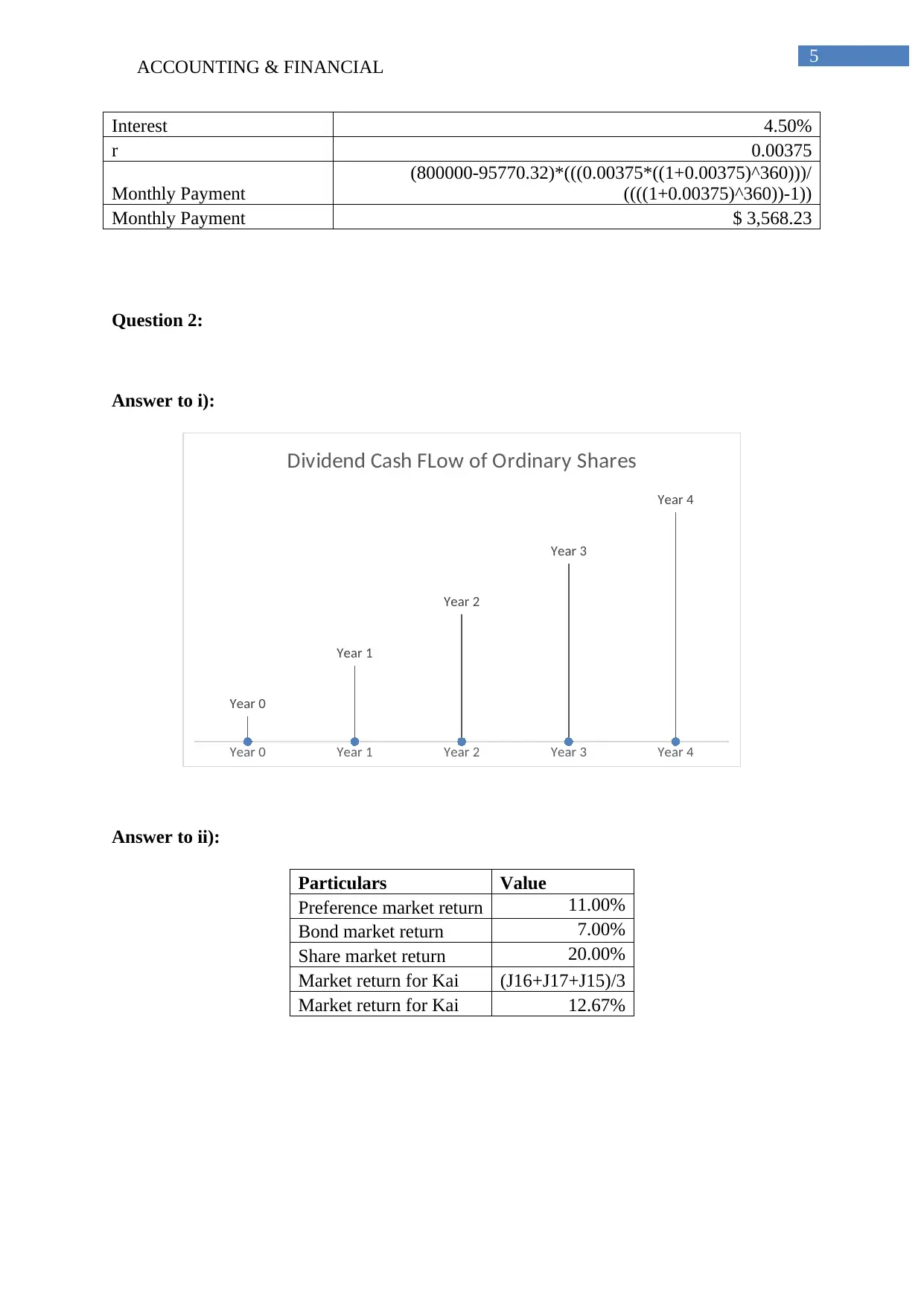
ACCOUNTING & FINANCIAL 5
Interest 4.50%
r 0.00375
Monthly Payment
(800000-95770.32)*(((0.00375*((1+0.00375)^360)))/
((((1+0.00375)^360))-1))
Monthly Payment $ 3,568.23
Question 2:
Answer to i):
Year 0 Year 1 Year 2 Year 3 Year 4
Year 0
Year 1
Year 2
Year 3
Year 4
Dividend Cash FLow of Ordinary Shares
Answer to ii):
Particulars Value
Preference market return 11.00%
Bond market return 7.00%
Share market return 20.00%
Market return for Kai (J16+J17+J15)/3
Market return for Kai 12.67%
Interest 4.50%
r 0.00375
Monthly Payment
(800000-95770.32)*(((0.00375*((1+0.00375)^360)))/
((((1+0.00375)^360))-1))
Monthly Payment $ 3,568.23
Question 2:
Answer to i):
Year 0 Year 1 Year 2 Year 3 Year 4
Year 0
Year 1
Year 2
Year 3
Year 4
Dividend Cash FLow of Ordinary Shares
Answer to ii):
Particulars Value
Preference market return 11.00%
Bond market return 7.00%
Share market return 20.00%
Market return for Kai (J16+J17+J15)/3
Market return for Kai 12.67%
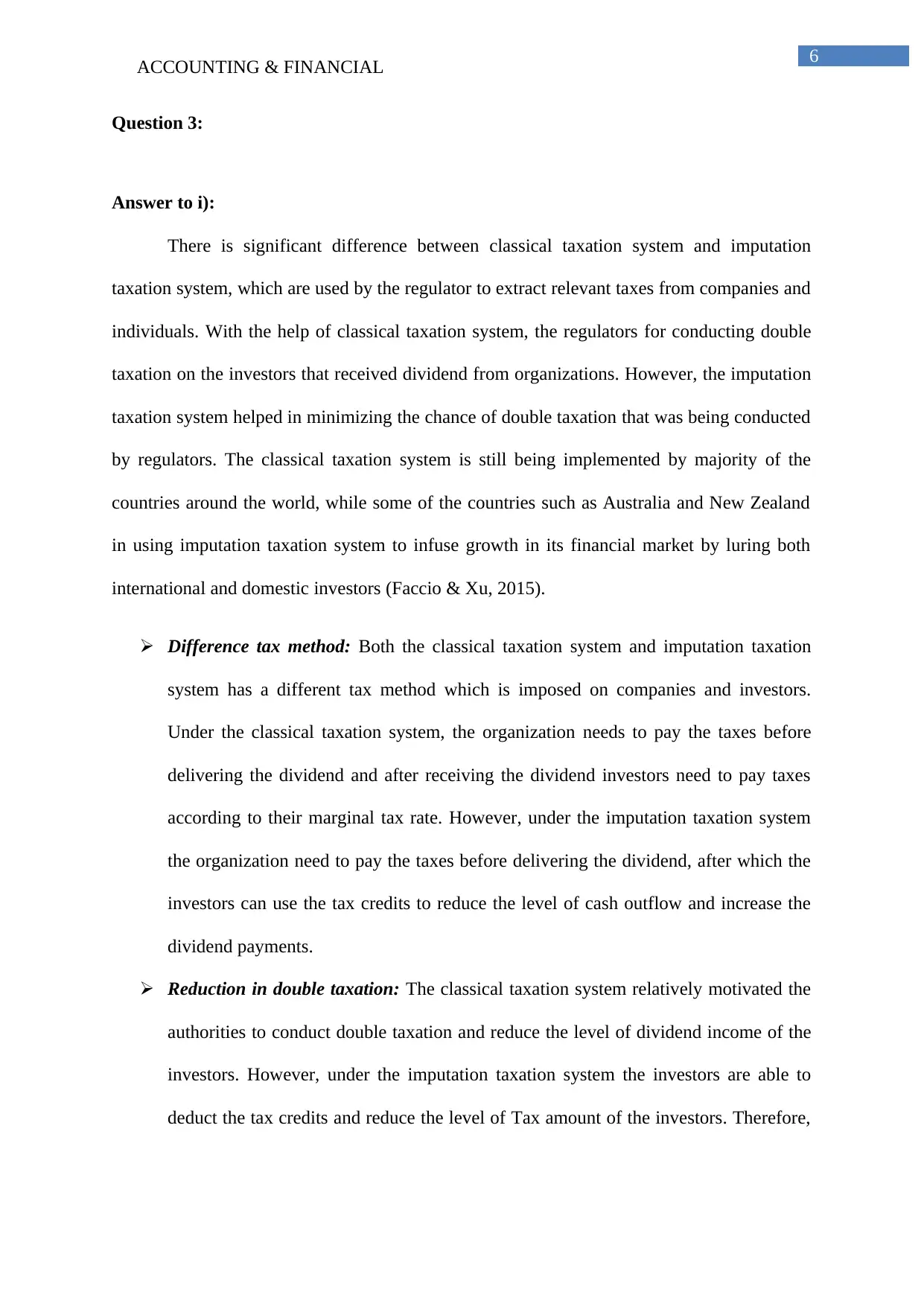
ACCOUNTING & FINANCIAL 6
Question 3:
Answer to i):
There is significant difference between classical taxation system and imputation
taxation system, which are used by the regulator to extract relevant taxes from companies and
individuals. With the help of classical taxation system, the regulators for conducting double
taxation on the investors that received dividend from organizations. However, the imputation
taxation system helped in minimizing the chance of double taxation that was being conducted
by regulators. The classical taxation system is still being implemented by majority of the
countries around the world, while some of the countries such as Australia and New Zealand
in using imputation taxation system to infuse growth in its financial market by luring both
international and domestic investors (Faccio & Xu, 2015).
Difference tax method: Both the classical taxation system and imputation taxation
system has a different tax method which is imposed on companies and investors.
Under the classical taxation system, the organization needs to pay the taxes before
delivering the dividend and after receiving the dividend investors need to pay taxes
according to their marginal tax rate. However, under the imputation taxation system
the organization need to pay the taxes before delivering the dividend, after which the
investors can use the tax credits to reduce the level of cash outflow and increase the
dividend payments.
Reduction in double taxation: The classical taxation system relatively motivated the
authorities to conduct double taxation and reduce the level of dividend income of the
investors. However, under the imputation taxation system the investors are able to
deduct the tax credits and reduce the level of Tax amount of the investors. Therefore,
Question 3:
Answer to i):
There is significant difference between classical taxation system and imputation
taxation system, which are used by the regulator to extract relevant taxes from companies and
individuals. With the help of classical taxation system, the regulators for conducting double
taxation on the investors that received dividend from organizations. However, the imputation
taxation system helped in minimizing the chance of double taxation that was being conducted
by regulators. The classical taxation system is still being implemented by majority of the
countries around the world, while some of the countries such as Australia and New Zealand
in using imputation taxation system to infuse growth in its financial market by luring both
international and domestic investors (Faccio & Xu, 2015).
Difference tax method: Both the classical taxation system and imputation taxation
system has a different tax method which is imposed on companies and investors.
Under the classical taxation system, the organization needs to pay the taxes before
delivering the dividend and after receiving the dividend investors need to pay taxes
according to their marginal tax rate. However, under the imputation taxation system
the organization need to pay the taxes before delivering the dividend, after which the
investors can use the tax credits to reduce the level of cash outflow and increase the
dividend payments.
Reduction in double taxation: The classical taxation system relatively motivated the
authorities to conduct double taxation and reduce the level of dividend income of the
investors. However, under the imputation taxation system the investors are able to
deduct the tax credits and reduce the level of Tax amount of the investors. Therefore,
⊘ This is a preview!⊘
Do you want full access?
Subscribe today to unlock all pages.

Trusted by 1+ million students worldwide
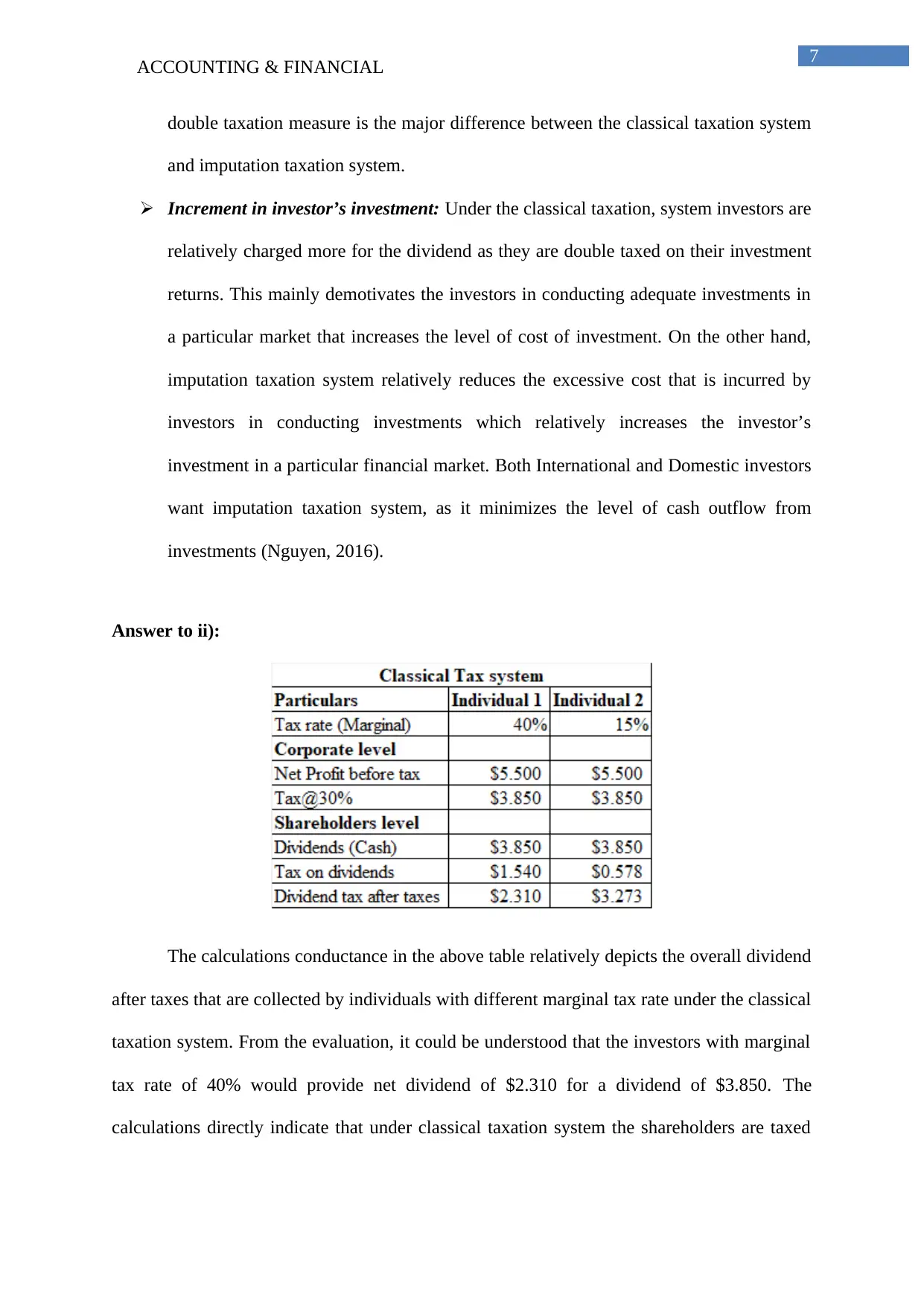
ACCOUNTING & FINANCIAL 7
double taxation measure is the major difference between the classical taxation system
and imputation taxation system.
Increment in investor’s investment: Under the classical taxation, system investors are
relatively charged more for the dividend as they are double taxed on their investment
returns. This mainly demotivates the investors in conducting adequate investments in
a particular market that increases the level of cost of investment. On the other hand,
imputation taxation system relatively reduces the excessive cost that is incurred by
investors in conducting investments which relatively increases the investor’s
investment in a particular financial market. Both International and Domestic investors
want imputation taxation system, as it minimizes the level of cash outflow from
investments (Nguyen, 2016).
Answer to ii):
The calculations conductance in the above table relatively depicts the overall dividend
after taxes that are collected by individuals with different marginal tax rate under the classical
taxation system. From the evaluation, it could be understood that the investors with marginal
tax rate of 40% would provide net dividend of $2.310 for a dividend of $3.850. The
calculations directly indicate that under classical taxation system the shareholders are taxed
double taxation measure is the major difference between the classical taxation system
and imputation taxation system.
Increment in investor’s investment: Under the classical taxation, system investors are
relatively charged more for the dividend as they are double taxed on their investment
returns. This mainly demotivates the investors in conducting adequate investments in
a particular market that increases the level of cost of investment. On the other hand,
imputation taxation system relatively reduces the excessive cost that is incurred by
investors in conducting investments which relatively increases the investor’s
investment in a particular financial market. Both International and Domestic investors
want imputation taxation system, as it minimizes the level of cash outflow from
investments (Nguyen, 2016).
Answer to ii):
The calculations conductance in the above table relatively depicts the overall dividend
after taxes that are collected by individuals with different marginal tax rate under the classical
taxation system. From the evaluation, it could be understood that the investors with marginal
tax rate of 40% would provide net dividend of $2.310 for a dividend of $3.850. The
calculations directly indicate that under classical taxation system the shareholders are taxed
Paraphrase This Document
Need a fresh take? Get an instant paraphrase of this document with our AI Paraphraser
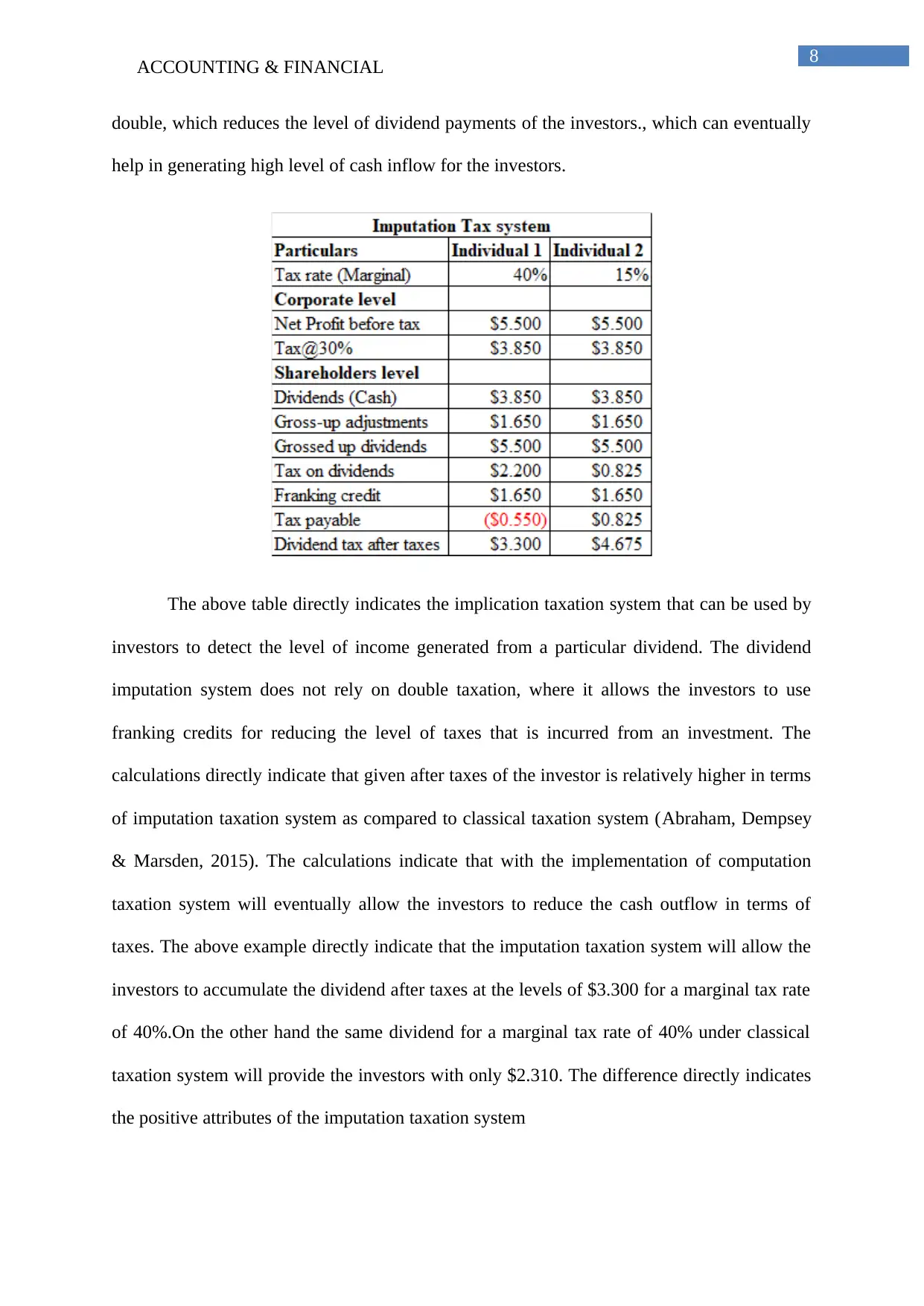
ACCOUNTING & FINANCIAL 8
double, which reduces the level of dividend payments of the investors., which can eventually
help in generating high level of cash inflow for the investors.
The above table directly indicates the implication taxation system that can be used by
investors to detect the level of income generated from a particular dividend. The dividend
imputation system does not rely on double taxation, where it allows the investors to use
franking credits for reducing the level of taxes that is incurred from an investment. The
calculations directly indicate that given after taxes of the investor is relatively higher in terms
of imputation taxation system as compared to classical taxation system (Abraham, Dempsey
& Marsden, 2015). The calculations indicate that with the implementation of computation
taxation system will eventually allow the investors to reduce the cash outflow in terms of
taxes. The above example directly indicate that the imputation taxation system will allow the
investors to accumulate the dividend after taxes at the levels of $3.300 for a marginal tax rate
of 40%.On the other hand the same dividend for a marginal tax rate of 40% under classical
taxation system will provide the investors with only $2.310. The difference directly indicates
the positive attributes of the imputation taxation system
double, which reduces the level of dividend payments of the investors., which can eventually
help in generating high level of cash inflow for the investors.
The above table directly indicates the implication taxation system that can be used by
investors to detect the level of income generated from a particular dividend. The dividend
imputation system does not rely on double taxation, where it allows the investors to use
franking credits for reducing the level of taxes that is incurred from an investment. The
calculations directly indicate that given after taxes of the investor is relatively higher in terms
of imputation taxation system as compared to classical taxation system (Abraham, Dempsey
& Marsden, 2015). The calculations indicate that with the implementation of computation
taxation system will eventually allow the investors to reduce the cash outflow in terms of
taxes. The above example directly indicate that the imputation taxation system will allow the
investors to accumulate the dividend after taxes at the levels of $3.300 for a marginal tax rate
of 40%.On the other hand the same dividend for a marginal tax rate of 40% under classical
taxation system will provide the investors with only $2.310. The difference directly indicates
the positive attributes of the imputation taxation system
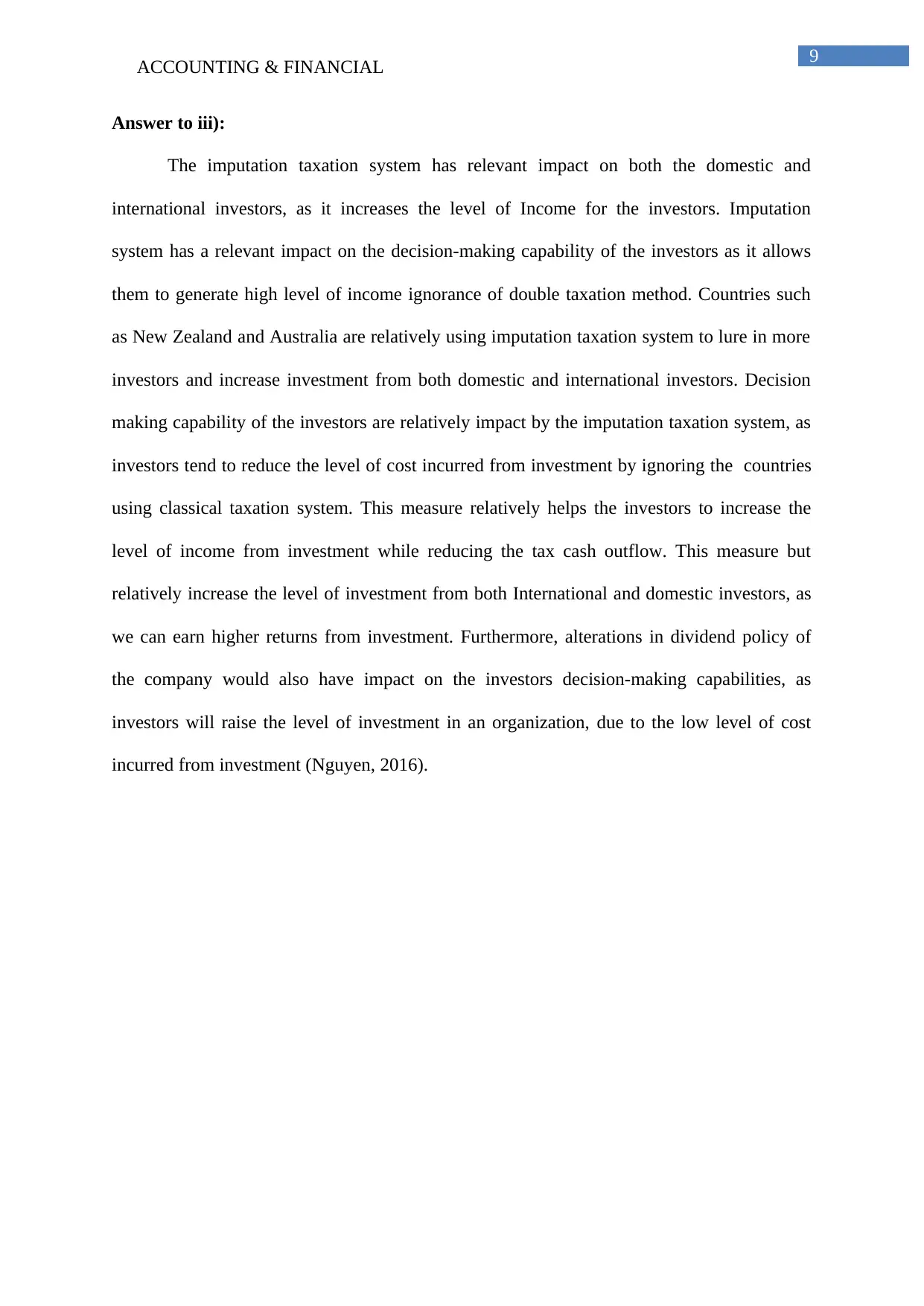
ACCOUNTING & FINANCIAL 9
Answer to iii):
The imputation taxation system has relevant impact on both the domestic and
international investors, as it increases the level of Income for the investors. Imputation
system has a relevant impact on the decision-making capability of the investors as it allows
them to generate high level of income ignorance of double taxation method. Countries such
as New Zealand and Australia are relatively using imputation taxation system to lure in more
investors and increase investment from both domestic and international investors. Decision
making capability of the investors are relatively impact by the imputation taxation system, as
investors tend to reduce the level of cost incurred from investment by ignoring the countries
using classical taxation system. This measure relatively helps the investors to increase the
level of income from investment while reducing the tax cash outflow. This measure but
relatively increase the level of investment from both International and domestic investors, as
we can earn higher returns from investment. Furthermore, alterations in dividend policy of
the company would also have impact on the investors decision-making capabilities, as
investors will raise the level of investment in an organization, due to the low level of cost
incurred from investment (Nguyen, 2016).
Answer to iii):
The imputation taxation system has relevant impact on both the domestic and
international investors, as it increases the level of Income for the investors. Imputation
system has a relevant impact on the decision-making capability of the investors as it allows
them to generate high level of income ignorance of double taxation method. Countries such
as New Zealand and Australia are relatively using imputation taxation system to lure in more
investors and increase investment from both domestic and international investors. Decision
making capability of the investors are relatively impact by the imputation taxation system, as
investors tend to reduce the level of cost incurred from investment by ignoring the countries
using classical taxation system. This measure relatively helps the investors to increase the
level of income from investment while reducing the tax cash outflow. This measure but
relatively increase the level of investment from both International and domestic investors, as
we can earn higher returns from investment. Furthermore, alterations in dividend policy of
the company would also have impact on the investors decision-making capabilities, as
investors will raise the level of investment in an organization, due to the low level of cost
incurred from investment (Nguyen, 2016).
⊘ This is a preview!⊘
Do you want full access?
Subscribe today to unlock all pages.

Trusted by 1+ million students worldwide
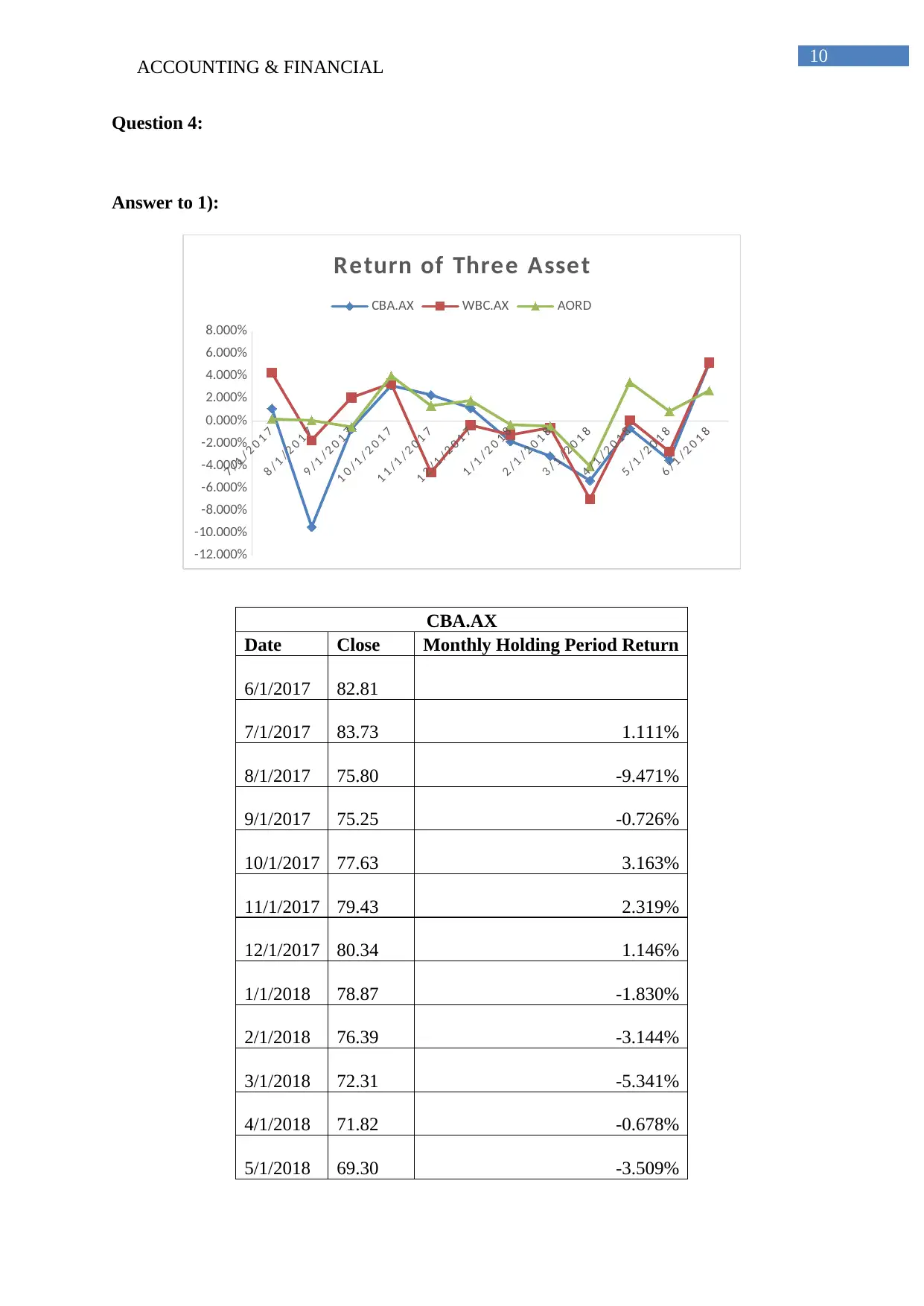
ACCOUNTING & FINANCIAL 10
Question 4:
Answer to 1):
7 / 1 / 2 0 1 7
8 / 1 / 2 0 1 7
9 / 1 / 2 0 1 7
1 0 / 1 / 2 0 1 7
1 1 / 1 / 2 0 1 7
1 2 / 1 / 2 0 1 7
1 / 1 / 2 0 1 8
2 / 1 / 2 0 1 8
3 / 1 / 2 0 1 8
4 / 1 / 2 0 1 8
5 / 1 / 2 0 1 8
6 / 1 / 2 0 1 8
-12.000%
-10.000%
-8.000%
-6.000%
-4.000%
-2.000%
0.000%
2.000%
4.000%
6.000%
8.000%
Return of Three Asset
CBA.AX WBC.AX AORD
CBA.AX
Date Close Monthly Holding Period Return
6/1/2017 82.81
7/1/2017 83.73 1.111%
8/1/2017 75.80 -9.471%
9/1/2017 75.25 -0.726%
10/1/2017 77.63 3.163%
11/1/2017 79.43 2.319%
12/1/2017 80.34 1.146%
1/1/2018 78.87 -1.830%
2/1/2018 76.39 -3.144%
3/1/2018 72.31 -5.341%
4/1/2018 71.82 -0.678%
5/1/2018 69.30 -3.509%
Question 4:
Answer to 1):
7 / 1 / 2 0 1 7
8 / 1 / 2 0 1 7
9 / 1 / 2 0 1 7
1 0 / 1 / 2 0 1 7
1 1 / 1 / 2 0 1 7
1 2 / 1 / 2 0 1 7
1 / 1 / 2 0 1 8
2 / 1 / 2 0 1 8
3 / 1 / 2 0 1 8
4 / 1 / 2 0 1 8
5 / 1 / 2 0 1 8
6 / 1 / 2 0 1 8
-12.000%
-10.000%
-8.000%
-6.000%
-4.000%
-2.000%
0.000%
2.000%
4.000%
6.000%
8.000%
Return of Three Asset
CBA.AX WBC.AX AORD
CBA.AX
Date Close Monthly Holding Period Return
6/1/2017 82.81
7/1/2017 83.73 1.111%
8/1/2017 75.80 -9.471%
9/1/2017 75.25 -0.726%
10/1/2017 77.63 3.163%
11/1/2017 79.43 2.319%
12/1/2017 80.34 1.146%
1/1/2018 78.87 -1.830%
2/1/2018 76.39 -3.144%
3/1/2018 72.31 -5.341%
4/1/2018 71.82 -0.678%
5/1/2018 69.30 -3.509%
Paraphrase This Document
Need a fresh take? Get an instant paraphrase of this document with our AI Paraphraser
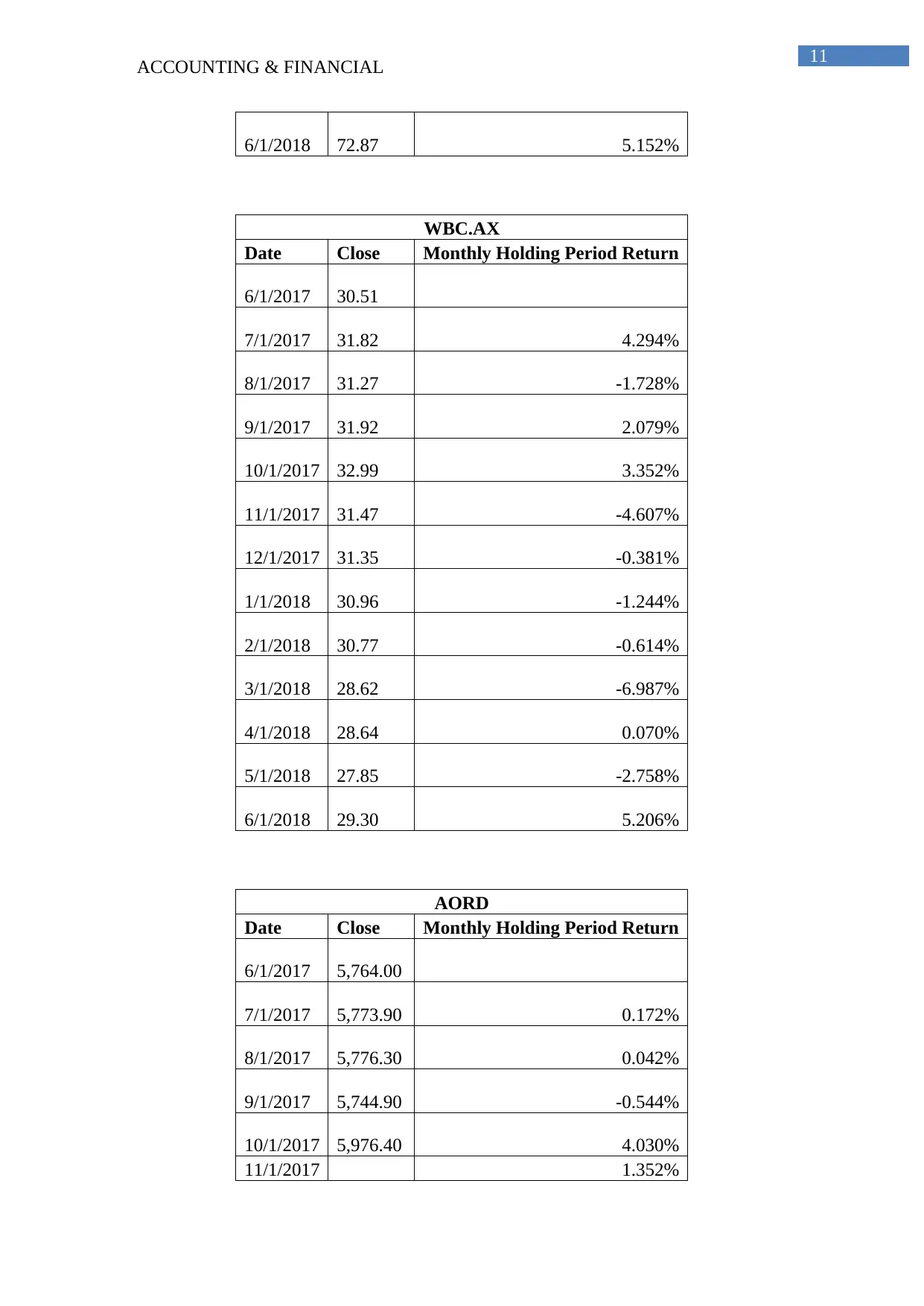
ACCOUNTING & FINANCIAL 11
6/1/2018 72.87 5.152%
WBC.AX
Date Close Monthly Holding Period Return
6/1/2017 30.51
7/1/2017 31.82 4.294%
8/1/2017 31.27 -1.728%
9/1/2017 31.92 2.079%
10/1/2017 32.99 3.352%
11/1/2017 31.47 -4.607%
12/1/2017 31.35 -0.381%
1/1/2018 30.96 -1.244%
2/1/2018 30.77 -0.614%
3/1/2018 28.62 -6.987%
4/1/2018 28.64 0.070%
5/1/2018 27.85 -2.758%
6/1/2018 29.30 5.206%
AORD
Date Close Monthly Holding Period Return
6/1/2017 5,764.00
7/1/2017 5,773.90 0.172%
8/1/2017 5,776.30 0.042%
9/1/2017 5,744.90 -0.544%
10/1/2017 5,976.40 4.030%
11/1/2017 1.352%
6/1/2018 72.87 5.152%
WBC.AX
Date Close Monthly Holding Period Return
6/1/2017 30.51
7/1/2017 31.82 4.294%
8/1/2017 31.27 -1.728%
9/1/2017 31.92 2.079%
10/1/2017 32.99 3.352%
11/1/2017 31.47 -4.607%
12/1/2017 31.35 -0.381%
1/1/2018 30.96 -1.244%
2/1/2018 30.77 -0.614%
3/1/2018 28.62 -6.987%
4/1/2018 28.64 0.070%
5/1/2018 27.85 -2.758%
6/1/2018 29.30 5.206%
AORD
Date Close Monthly Holding Period Return
6/1/2017 5,764.00
7/1/2017 5,773.90 0.172%
8/1/2017 5,776.30 0.042%
9/1/2017 5,744.90 -0.544%
10/1/2017 5,976.40 4.030%
11/1/2017 1.352%
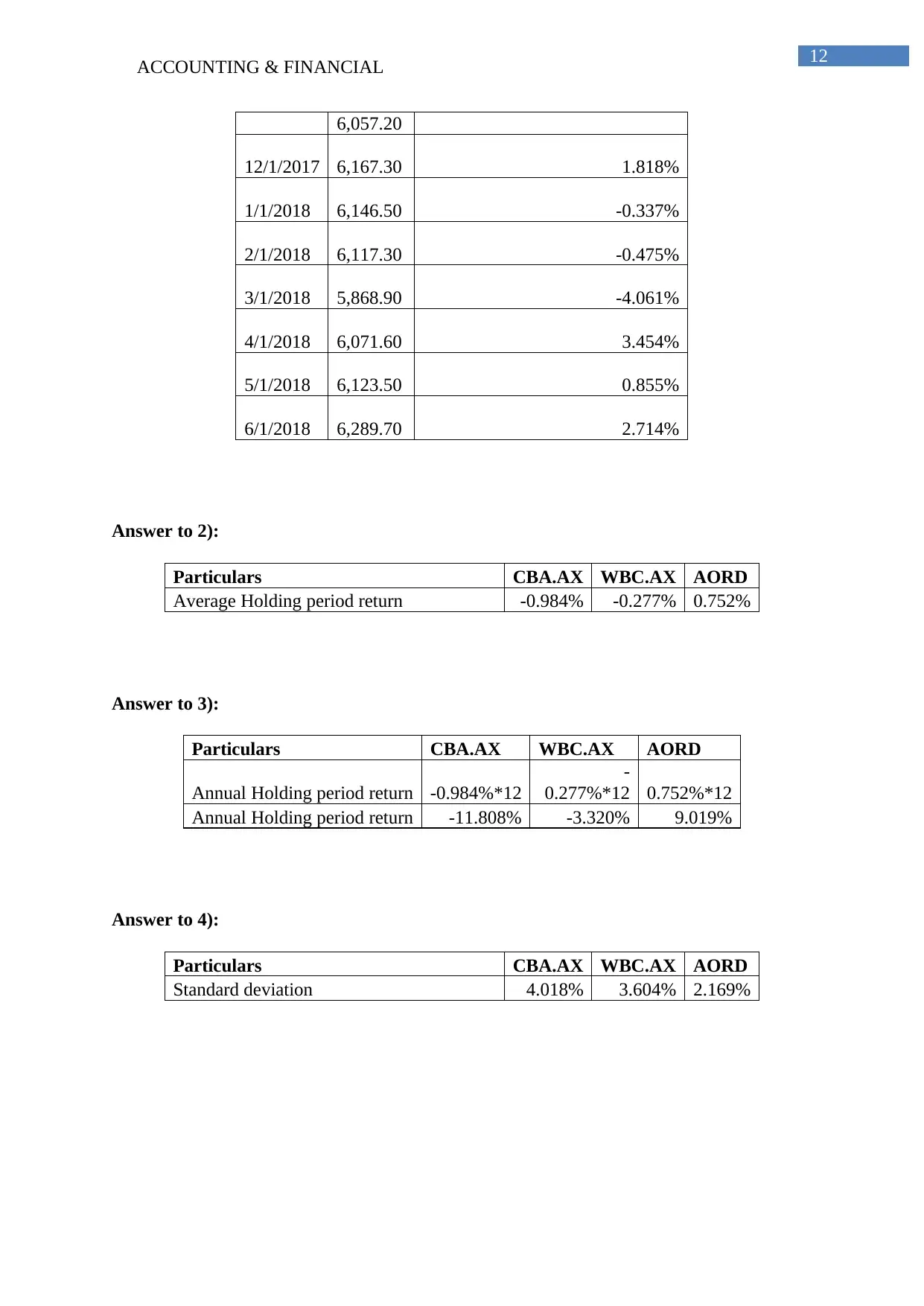
ACCOUNTING & FINANCIAL 12
6,057.20
12/1/2017 6,167.30 1.818%
1/1/2018 6,146.50 -0.337%
2/1/2018 6,117.30 -0.475%
3/1/2018 5,868.90 -4.061%
4/1/2018 6,071.60 3.454%
5/1/2018 6,123.50 0.855%
6/1/2018 6,289.70 2.714%
Answer to 2):
Particulars CBA.AX WBC.AX AORD
Average Holding period return -0.984% -0.277% 0.752%
Answer to 3):
Particulars CBA.AX WBC.AX AORD
Annual Holding period return -0.984%*12
-
0.277%*12 0.752%*12
Annual Holding period return -11.808% -3.320% 9.019%
Answer to 4):
Particulars CBA.AX WBC.AX AORD
Standard deviation 4.018% 3.604% 2.169%
6,057.20
12/1/2017 6,167.30 1.818%
1/1/2018 6,146.50 -0.337%
2/1/2018 6,117.30 -0.475%
3/1/2018 5,868.90 -4.061%
4/1/2018 6,071.60 3.454%
5/1/2018 6,123.50 0.855%
6/1/2018 6,289.70 2.714%
Answer to 2):
Particulars CBA.AX WBC.AX AORD
Average Holding period return -0.984% -0.277% 0.752%
Answer to 3):
Particulars CBA.AX WBC.AX AORD
Annual Holding period return -0.984%*12
-
0.277%*12 0.752%*12
Annual Holding period return -11.808% -3.320% 9.019%
Answer to 4):
Particulars CBA.AX WBC.AX AORD
Standard deviation 4.018% 3.604% 2.169%
⊘ This is a preview!⊘
Do you want full access?
Subscribe today to unlock all pages.

Trusted by 1+ million students worldwide
1 out of 15
Related Documents
Your All-in-One AI-Powered Toolkit for Academic Success.
+13062052269
info@desklib.com
Available 24*7 on WhatsApp / Email
![[object Object]](/_next/static/media/star-bottom.7253800d.svg)
Unlock your academic potential
Copyright © 2020–2025 A2Z Services. All Rights Reserved. Developed and managed by ZUCOL.




